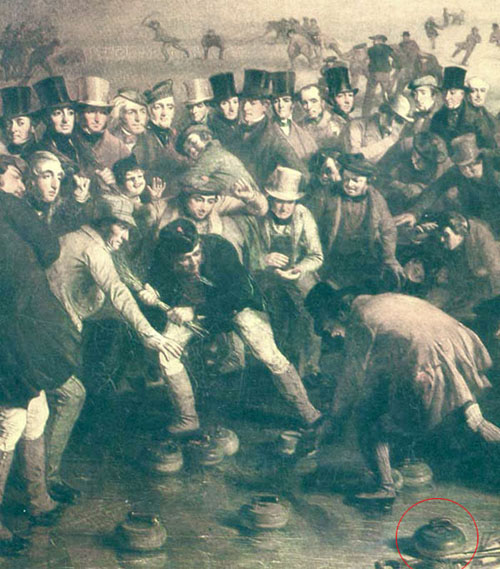Some 100 stones were found in the garden of David and Hazel's home in Troon when the task of relocating David's bequest of his curling memorabilia to the Scottish Curling Trust was undertaken on his death last year. These were in addition to the 300 or so stones that were inside the house, which are now safely in store at Stirling.
Andrew Kerr, a Director of Ayrshire Curlers Ltd and David's friend, was one of those who helped in moving the collection to Stirling, a mammoth task. Andrew, and fellow Director, Gemmill Jack, are those who came up with the idea for the wall at David's home curling rink at Ayr, using the stones from the garden.
David's knowledge of curling's history was unmatched. I miss him very much. Hardly a day goes by when I come up with a question to which David would immediately have had the answer. Andrew says, "I too miss David. Many is the night I would bring him home and have a dram together talking about curling matters."
Whereas rare and important curling stones found a place inside their house in Troon, David and Hazel's garden was a 'sanctuary' for old curling stones. No matter how unloved in their previous existence, they found a home at Troon, and, on a sunny day outside, they were a worthy topic of conversation.
And they can continue to be discussed over! Forget for the moment that these stones have no handles, they all have stories to tell. One can ask two questions right off: how old are they, and what type of stone are they made from?
Take, as an example, the three stones on the top tier of the wall in the photo above. All are single-soled stones, and that dates them from before the middle of the nineteenth century. (I use a date of 1850 as roughly when reversible double soled stones were first manufactured.) The stone on the left is the earliest example - the hole in which the handle was seated is off to the side, the handle itself being L-shaped. The earliest of this type of stone would have had an iron handle, as on the stone that adorns the little pyramid of stones accompanying the wall, see above, permanently fixed in place. It may even have been made in the eighteenth century.
The other two are later. The one on the right (of Common Ailsa) and that in the middle (Carsphairn?) are single soled stones, but with the attachment for the handle in the centre of the stone. This was a small threaded iron bolt, the remains still in place in these two examples, onto which the handle would have been screwed. These handles were the earliest with a 'goose-neck' shape, and were removable.
We can date curling stones by reference to the great curling paintings of the nineteenth century. If you haven't already done so, take a trip to the National Portrait Gallery in Edinburgh where the beautifully restored painting of the Grand Match at Linlithgow by Charles Lees now hangs, see here.
The painting depicts the 1848 Grand Match. We can safely assume that the artist painted what he saw. In the detail above, most of the stones are single-soled, with offset handles. But one stands out as different, as I've highlighted. This is a single-soled stone with a centred handle. Such stones may be considered as a fairly short lived phase in curling stone evolution!
If you study closely the earlier famous painting of The Curlers by George Harvey, from 1835, see here, you will also see one odd stone which looks to be of this type.
Here's another from the wall. What stories could it tell of matches played many years ago? Where, I wonder? And who was AW, its proud owner who saw that his initials were inscribed onto it?
David's Wall is a wonderful reminder of a great man. I am sure he would appreciate it if you consider it as more than a wall of 'old stones', but as a reminder of games played, and enjoyed, on outside ice many years ago.
Photos © Skip Cottage, and my own thanks to Kirsty Letton.






1 comment:
thank you for the history lesson and for honoring DAVID.
Post a Comment